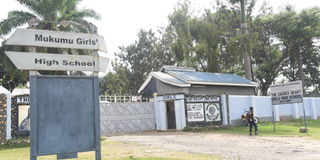Mukumu Girls: Killer illness is severe typhoid from contaminated water

The entrance of Mukumu Girls High School in Kakamega County. Kakamega Senator Boni Khalwale accuses the County Director of Education and the school principal of failing to contain a recent disease outbreak at the institution.
A report on the disease outbreak that has so far killed four people at Mukumu Girls' Secondary School in Kakamega County indicates a case of severe typhoid from water contaminated with salmonella typhi. Results of tests shared by the Ministry of Health Friday also show that the infection that has seen three students and one teacher die this month is a mixture of both salmonella and enterotoxigenic e-coli bacteria.
Enterotoxigenic e-coli is typically transmitted by food or water contaminated with animal or human faeces and causes bacterial diarrheal illness. Salmonella -- the bacteria that causes typhoid fever which can be fatal if not treated effectively -- is also spread through contaminated food, water or close contact.
When the outbreak first struck at Mukumu Girls', at least 246 students were hospitalised with vomiting, diarrhoea and dizziness, which are typically symptoms of a salmonella infection. At that stage, Ministry and county officials inspected the school and opened an investigation, which saw samples collected and taken to the Kenya Medical Research Institute (Kemri) for analysis.
In a statement on Friday, the Ministry said that the number had increased to 627, with patients from both Mukumu Girls' and Butere Boys'. It said 19 patients were at seven health facilities across the country and that they were all stable. The two schools were closed.
On Friday, a report from Kemri showed that the affected students suffered severe typhoid. Kemri said laboratory tests found water contamination bY E. coli and Salmonella Typhi caused the illness.
Earlier, a post-mortem found that the third student who died at Kakamega General Hospital suffered from multiple organ failure due to a bacterial infection.
Also read: Schools should hire nutrition, food experts
In its investigation, the ministry further analysed grains and pulses for aflatoxin and tested for viral haemorrhagic fevers including the Ebola and Marburg virus diseases, leptospirosis and the crimean-Congo haemorrhagic fever, dengue fever, the Rift Valley fever and the West Nile virus. All these tests were negative.
In a statement, Dr Patrick Amoth, the director-general for health, said, "The ministry is conducting further analysis to ascertain any other potential cause of the illness."





